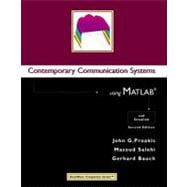
What is included with this book?
| 1 Signals and Linear Systems | 1 | (44) | |||
|
1 | (1) | |||
|
1 | (17) | |||
|
13 | (5) | |||
|
18 | (14) | |||
|
23 | (5) | |||
|
28 | (4) | |||
|
32 | (4) | |||
|
36 | (9) | |||
| 2 Random Processes | 45 | (36) | |||
|
45 | (1) | |||
|
45 | (5) | |||
|
50 | (7) | |||
|
57 | (5) | |||
|
62 | (6) | |||
|
68 | (6) | |||
|
74 | (7) | |||
| 3 Analog Modulation | 81 | (51) | |||
|
81 | (1) | |||
|
81 | (22) | |||
|
82 | (9) | |||
|
91 | (7) | |||
|
98 | (5) | |||
|
103 | (16) | |||
|
103 | (6) | |||
|
109 | (5) | |||
|
114 | (5) | |||
|
119 | (13) | |||
| 4 Analog-to-Digital Conversion | 132 | (41) | |||
|
132 | (1) | |||
|
132 | (6) | |||
|
133 | (5) | |||
|
138 | (35) | |||
|
139 | (9) | |||
|
148 | (7) | |||
|
155 | (1) | |||
|
155 | (18) | |||
| 5 Baseband Digital Transmission | 173 | (53) | |||
|
173 | (1) | |||
|
173 | (21) | |||
|
174 | (10) | |||
|
184 | (9) | |||
|
193 | (1) | |||
|
194 | (12) | |||
|
194 | (3) | |||
|
197 | (6) | |||
|
203 | (3) | |||
|
206 | (20) | |||
|
207 | (9) | |||
|
216 | (10) | |||
| 6 Digital Transmission Through Bandlimited Channels | 226 | (55) | |||
|
226 | (1) | |||
|
226 | (5) | |||
|
231 | (9) | |||
|
240 | (7) | |||
|
247 | (13) | |||
|
247 | (5) | |||
|
252 | (5) | |||
|
257 | (3) | |||
|
260 | (13) | |||
|
268 | (5) | |||
|
273 | (8) | |||
| 7 Digital Transmission via Carrier Modulation | 281 | (63) | |||
|
281 | (1) | |||
|
281 | (6) | |||
|
284 | (3) | |||
|
287 | (16) | |||
|
290 | (6) | |||
|
296 | (7) | |||
|
303 | (8) | |||
|
304 | (2) | |||
|
306 | (5) | |||
|
311 | (11) | |||
|
311 | (2) | |||
|
313 | (5) | |||
|
318 | (4) | |||
|
322 | (6) | |||
|
328 | (16) | |||
|
328 | (6) | |||
|
334 | (10) | |||
| 8 Channel Capacity and Coding | 344 | (47) | |||
|
344 | (1) | |||
|
344 | (12) | |||
|
345 | (1) | |||
|
345 | (11) | |||
|
356 | (35) | |||
|
358 | (14) | |||
|
372 | (19) | |||
| 9 Spread Spectrum Communication Systems | 391 | (31) | |||
|
391 | (1) | |||
|
392 | (11) | |||
|
394 | (2) | |||
|
396 | (1) | |||
|
397 | (6) | |||
|
403 | (6) | |||
|
409 | (13) | |||
|
410 | (5) | |||
|
415 | (7) | |||
| 10 Simulink Tutorial on Digital Modulation Methods | 422 | (63) | |||
|
422 | (1) | |||
|
423 | (7) | |||
|
423 | (7) | |||
|
430 | (1) | |||
|
431 | (12) | |||
|
432 | (5) | |||
|
437 | (6) | |||
|
443 | (14) | |||
|
445 | (6) | |||
|
451 | (3) | |||
|
454 | (3) | |||
|
457 | (9) | |||
|
457 | (4) | |||
|
461 | (5) | |||
|
466 | (5) | |||
|
466 | (1) | |||
|
467 | (4) | |||
|
471 | (6) | |||
|
471 | (1) | |||
|
471 | (6) | |||
|
477 | (8) | |||
|
477 | (4) | |||
|
481 | (4) | |||
| Bibliography | 485 | (1) | |||
| Index | 486 |
The New copy of this book will include any supplemental materials advertised. Please check the title of the book to determine if it should include any access cards, study guides, lab manuals, CDs, etc.
The Used, Rental and eBook copies of this book are not guaranteed to include any supplemental materials. Typically, only the book itself is included. This is true even if the title states it includes any access cards, study guides, lab manuals, CDs, etc.